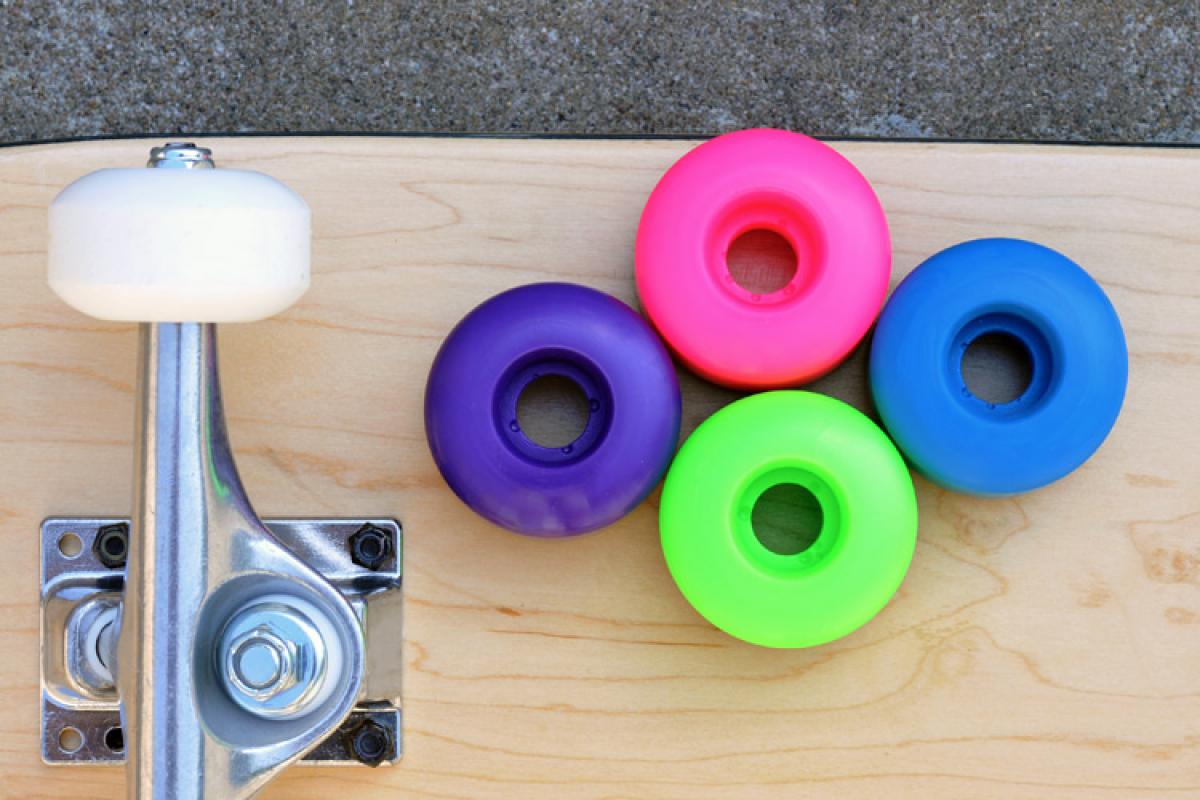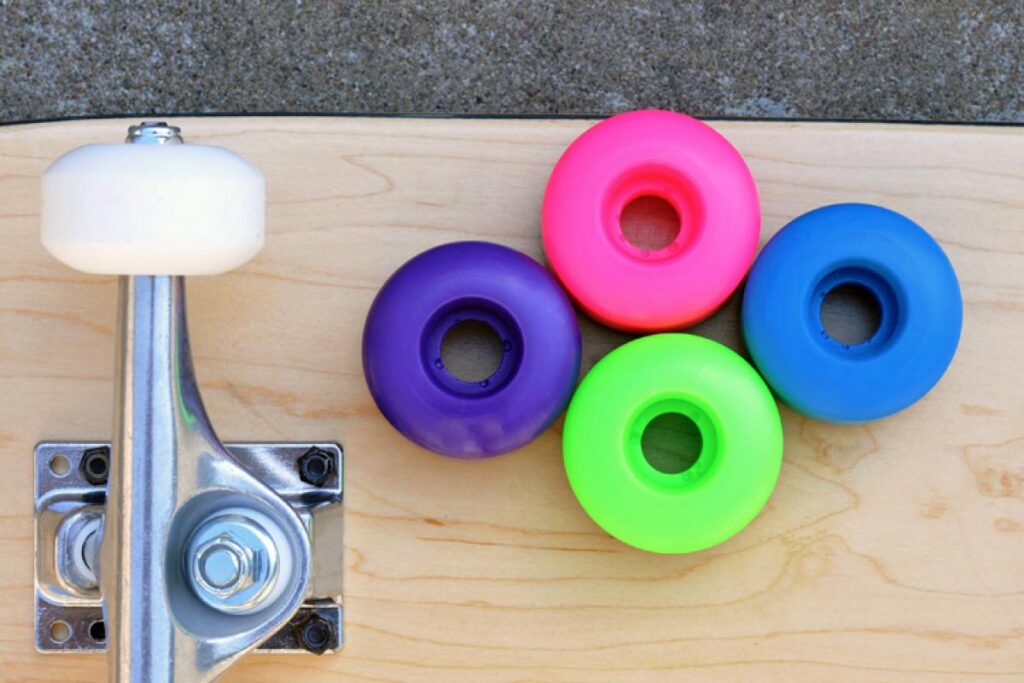Skateboard wheel hardness determines the wheel’s ability to accelerate and maintain speed. Skateboarders should consider the terrain they’ll be riding on when selecting the appropriate wheel hardness.
Skating on rough terrain requires harder wheels, while smoother surfaces require softer ones. Skateboarding is a sport that requires a lot of skill and proper equipment. One of the most important components of a skateboard is its wheels. Skateboard wheels come in different sizes, shapes, and hardness levels. Hardness is the most essential characteristic of skateboard wheels, and it’s measured on a scale called the durometer. Understanding the hardness of skateboard wheels is crucial for skateboarders because it affects how the board performs. In this article, we’ll explore skateboard wheel hardness, including how it’s determined and why it’s essential for different types of terrain.

Credit: www.surfertoday.com
Understanding Skateboard Wheel Hardness
Skateboarding is a thrilling sport that requires proper equipment. Among the essential parts of a skateboard are the wheels. They come in various sizes, shapes, and hardness levels, which can affect your skating experience significantly. In this section, we will focus on the hardness level of skateboard wheels, explaining what it is, what makes it important, and how it impacts your ride.
So, are you ready to dive deeper into the world of skateboard wheels? Let’s get started with our key headings, adhering to markdown syntax.
What Is Skateboard Wheel Hardness?
Skateboard wheel hardness refers to the durometer or density level of the wheels. The higher the durometer number, the harder the wheels, while lower numbers indicate softer wheels. Skateboard wheel hardness is usually measured on a scale ranging from 0 to 100.
The standard range for skateboard wheels is about 75a to 101a. The number is usually imprinted on the wheel in large print for easy identification.
What Are Durometers?
As mentioned earlier, durometers are devices used to measure the hardness or density of a material. In the skateboarding world, durometers help measure the hardness level of skateboard wheels. They are small, handheld devices with a clamp that you can press against the wheel to get the reading.
Durometers are usually available in two types: shore a and d scales. The shore a scale is the most commonly used for skateboarding wheel hardness measurement.
Factors That Impact Skateboard Wheel Hardness
Several factors can affect the hardness level of skateboard wheels, including:
- The size of the skateboard wheels: smaller wheels tend to be harder, while larger wheels are usually softer.
- The type of terrain: rough and rugged terrain requires softer wheels with more grip, while smoother terrain allows for harder wheels for greater speed.
- The rider’s weight: heavier riders may need softer wheels for smoother rides, while lighter individuals can use harder wheels for greater speed and control.
Ultimately, the hardness level of your skateboard wheels plays a significant role in your skateboarding experience. Whether you prefer softer wheels for cruising around the city or harder wheels for performing tricks, understanding skateboard wheel hardness can help you choose the right set of wheels for your needs.
So, keep these factors in mind when selecting your skateboard wheels and enjoy every ride to the fullest.
Different Types Of Skateboard Wheels
Skateboarding is a fun activity that has been around for years, and the technology behind the boards and wheels has evolved significantly. Skateboard wheels are available in a variety of hardness levels, and choosing the right ones can be overwhelming for beginners.
In this article, we’ll dive into the different types of skateboard wheels and explain what each one is designed for.
Soft Wheels
Soft skateboard wheels are typically made of a softer durometer urethane material. Their hardness level typically ranges from 75a to 85a, making them suitable for cruising, commuting, and smooth riding on rough surfaces.
- Soft wheels make riding on rough pavement and cracks smoother and more comfortable.
- They provide more grip, which is great for beginners as it helps with balance and stability.
- Soft wheels absorb shock better, making them suitable for long-distance rides and rough terrains.
- They are not ideal for performing tricks because they lack the speed and slide control of harder wheels.
Medium Wheels
Medium skateboard wheels are the most versatile type, with a hardness level ranging from 85a to 95a. They are considered the sweet spot between soft and hard wheels, and most skateboarders prefer them.
- Medium wheels allow you to balance speed and grip.
- They are suitable for cruising around town, commuting, and performing tricks.
- These wheels offer a smoother ride than hard wheels and more control than soft wheels.
- They are not ideal for long-distance rides and extremely rough terrains.
Hard Wheels
Hard skateboard wheels are the most durable and long-lasting type, with a hardness level ranging from 96a to 101a. They are designed for performing tricks and skateboarding in skateparks.
- Hard wheels are faster and provide better slide control, perfect for performing tricks and grinding.
- They are not ideal for cruising, commuting, or riding on rough surfaces as they provide less grip and absorb shock poorly.
- Hard wheels are more durable and longer-lasting than soft and medium wheels.
- They tend to be noisy and vibrate more because they have less give than softer wheels.
Choosing the right skateboard wheels can make a significant difference in your riding experience. Soft wheels are ideal for cruising, commuting, and smooth riding, medium wheels are the most versatile, suitable for most types of riding and performing tricks, while hard wheels are designed for skateparks and performing tricks.
Always consider the wheel’s hardness level before purchasing, as it can significantly impact your ride.
How to Choose Skateboard Wheels | Tactics
Choosing The Right Skateboard Wheels
Skateboarding is a thrilling sport that requires you to have the most suitable equipment for safety and efficiency. In skateboarding, wheels play a significant role in determining how your board rolls. Skateboard wheel hardness is a crucial aspect that you need to consider before purchasing skateboard wheels.
The hardness of skateboard wheels is measured in durometer, which is the measurement of the wheel’s hardness. This post will give you tips on how to choose the right skateboard wheels based on hardness.
Factors To Consider
Your skateboard wheel’s durometer affects your skating experience and is a vital factor to consider when choosing the perfect wheels.
- Weight: heavier riders require harder wheels with high durometer ratings to support them, while lighter riders can use wheels with lower durometer ratings.
- Terrain: different terrains require different kinds of wheels and durometer ratings. Rough surfaces and streets require harder wheels, while soft wheels are suitable for smooth surfaces such as skateparks.
- Speed: the faster you want to go, the harder your wheels should be. Hard wheels have less grip on the ground, so they roll faster than soft wheels.
Tips For Choosing The Best Wheels
Your skateboard wheels must fit your riding style and preferences to get the most out of your skating experience.
- Understand your skateboarding style: different skateboarders have varying styles and preferences. Street skateboarders prefer wheels with higher durometer ratings since they are harder and offer less grip. In contrast, longboarders, who prioritize cruising, opt for wheels with lower durometer ratings, which provide more grip and smooth rides.
- Know your terrain: as mentioned earlier, terrain plays a significant role in choosing the right skateboard wheels. If you mostly ride on smooth surfaces, get wheels with lower durometer ratings, while rough surfaces require wheels with higher durometer ratings.
- Get the right size: skateboard wheels come in varying sizes ranging from 49mm to 75mm. Small wheels are slow and need more effort to roll while large wheels provide faster rides. Ensure that you get the right size for your intended purpose and style.
- Experiment: experimenting with different wheels can help you narrow down your preferences and needs. Try out different types of wheels, including varying durometer ratings, sizes, and shapes, before settling on the perfect fit.
Choosing the perfect skateboard wheels can be transform your skating experience. The hardness of skateboard wheels can make a significant difference in your safety, speed, and overall experience. Ensure that you consider the factors above and follow the tips to find the perfect wheels for your needs and preferences.
Maintenance And Care For Skateboard Wheels
Skateboarding can wear down your wheels quickly, and it’s essential to take good care of them to prolong their life and keep your skateboard running smoothly. Here are some tips on how to maintain and care for your skateboard wheels.
Cleaning Your Wheels
Keeping your wheels clean is crucial to make them last longer. Dirt, dust, and debris can get lodged in the wheels’ bearings and slow down your skateboard.
- Remove your wheels from the skateboard.
- Use a soft-bristle brush to remove dirt and debris from your wheels.
- Soak them in warm soapy water for a few minutes.
- Use a toothbrush or a soft-bristle brush to scrub each wheel, including the bearings and the axles.
- Rinse the wheels with clean water and let them dry.
Storage
Storing your skateboard properly ensures that your wheels stay in good condition for a more extended period.
- Store your skateboard in a cool, dry place where it’s not exposed to extreme temperatures and humidity.
- Remove the wheels if you’re not going to ride your skateboard for an extended period. It takes the load off the bearings and prevents flat spots from developing on your wheels.
- Keep your wheels in a protective case or cover to protect them from dust and debris.
Replacement
Eventually, your skateboard wheels will wear down, and you’ll need to replace them.
- Physically damaged wheels: cracks or chips in the wheel can lessen the wheel’s overall quality, which can lead to an uneven roll.
- Uneven wear: skateboard wheels wear out unevenly with time, depending on how you skate. Look out for how much wheel you have left.
- Noisy or slow ride: if your skateboard ride gets noisy, or you feel like your board is slow, it could be time to replace your wheels.
Regularly checking your wheels for wear and tear and cleaning them after every ride can help prolong their life. Remember to store them properly and replace them when they show signs of damage or wear. Keep your skateboard wheels in optimal condition to enjoy smooth rides and advanced tricks.
Conclusion
Skateboard wheel hardness plays a crucial role in determining the performance of skateboard wheels. The measurement of the durometer rating tells us the level of hardness the wheel has. To choose the right skateboard wheel hardness, we must consider the different factors such as terrain, weight, and skating style.
Softer wheels are great for cruising and rough terrain, while harder wheels are more suitable for smooth surfaces and tricks. Keeping your skateboard wheels well-maintained will also prolong their lifespan. Finally, understanding the importance of skateboard wheel hardness and choosing the right ones can make a significant difference in your skating experience.



